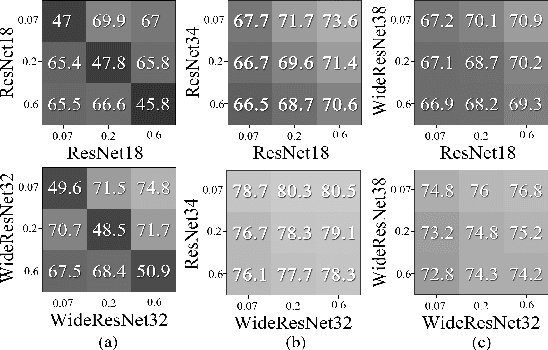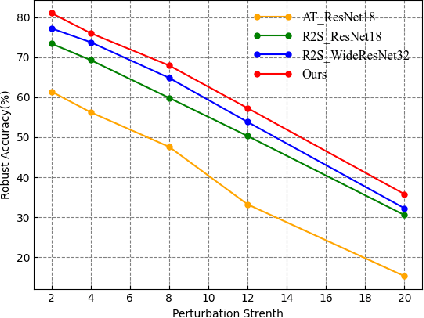Qi Peng
Dynamic Stochastic Ensemble with Adversarial Robust Lottery Ticket Subnetworks
Oct 06, 2022



Abstract:Adversarial attacks are considered the intrinsic vulnerability of CNNs. Defense strategies designed for attacks have been stuck in the adversarial attack-defense arms race, reflecting the imbalance between attack and defense. Dynamic Defense Framework (DDF) recently changed the passive safety status quo based on the stochastic ensemble model. The diversity of subnetworks, an essential concern in the DDF, can be effectively evaluated by the adversarial transferability between different networks. Inspired by the poor adversarial transferability between subnetworks of scratch tickets with various remaining ratios, we propose a method to realize the dynamic stochastic ensemble defense strategy. We discover the adversarial transferable diversity between robust lottery ticket subnetworks drawn from different basic structures and sparsity. The experimental results suggest that our method achieves better robust and clean recognition accuracy by adversarial transferable diversity, which would decrease the reliability of attacks.
An Improved Automatic Modulation Classification Scheme Based on Adaptive Fusion Network
Mar 07, 2022



Abstract:Due to the over-fitting problem caused by imbalance samples, there is still room to improve the performance of data-driven automatic modulation classification (AMC) in noisy scenarios. By fully considering the signal characteristics, an AMC scheme based on adaptive fusion network (AFNet) is proposed in this work. The AFNet can extract and aggregate multi-scale spatial features of in-phase and quadrature (I/Q) signals intelligently, thus improving the feature representation capability. Moreover, a novel confidence weighted loss function is proposed to address the imbalance issue and it is implemented by a two-stage learning scheme.Through the two-stage learning, AFNet can focus on high-confidence samples with more valid information and extract effective representations, so as to improve the overall classification performance. In the simulations, the proposed scheme reaches an average accuracy of 62.66% on a wide range of SNRs, which outperforms other AMC models. The effects of the loss function on classification accuracy are further studied.
A density compensation-based path computing model for measuring semantic similarity
Jun 03, 2015



Abstract:The shortest path between two concepts in a taxonomic ontology is commonly used to represent the semantic distance between concepts in the edge-based semantic similarity measures. In the past, the edge counting is considered to be the default method for the path computation, which is simple, intuitive and has low computational complexity. However, a large lexical taxonomy of such as WordNet has the irregular densities of links between concepts due to its broad domain but. The edge counting-based path computation is powerless for this non-uniformity problem. In this paper, we advocate that the path computation is able to be separated from the edge-based similarity measures and form various general computing models. Therefore, in order to solve the problem of non-uniformity of concept density in a large taxonomic ontology, we propose a new path computing model based on the compensation of local area density of concepts, which is equal to the number of direct hyponyms of the subsumers of concepts in their shortest path. This path model considers the local area density of concepts as an extension of the edge-based path and converts the local area density divided by their depth into the compensation for edge-based path with an adjustable parameter, which idea has been proven to be consistent with the information theory. This model is a general path computing model and can be applied in various edge-based similarity algorithms. The experiment results show that the proposed path model improves the average correlation between edge-based measures with human judgments on Miller and Charles benchmark from less than 0.8 to more than 0.85, and has a big advantage in efficiency than information content (IC) computation in a dynamic ontology, thereby successfully solving the non-uniformity problem of taxonomic ontology.
 Add to Chrome
Add to Chrome Add to Firefox
Add to Firefox Add to Edge
Add to Edge